|
|
Canku Ota |
|
|
(Many Paths) |
||
|
An Online Newsletter Celebrating Native America |
||
|
February 22, 2003 - Issue 81 |
||
|
|
||
|
Iktomi and the Ducks, or Why Ducks Have Red Eyes |
||
|
As told by Zitkala-Sa (Gertrude
Simmons Bonnin)
|
||
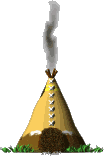 One
day Iktomi sat hungry within his teepee. Suddenly he rushed out, dragging
after him his blanket. Quickly spreading it on the ground, he tore up
dry tall grass with both his hands and tossed it fast into the blanket. One
day Iktomi sat hungry within his teepee. Suddenly he rushed out, dragging
after him his blanket. Quickly spreading it on the ground, he tore up
dry tall grass with both his hands and tossed it fast into the blanket.
Tying all the four corners together in a knot, he threw the light bundle of grass over his shoulder. Snatching up a slender willow stick with his free left hand, he started off with a hop and a leap. From side to side bounced, the bundle on his back, as he ran light-footed over the uneven ground. Soon he came to the edge of the great level land. On the hilltop he paused for breath. With wicked smacks of his dry parched lips, as if tasting some tender meat, he looked straight into space toward the marshy river bottom. With a thin palm shading his eyes from the western sun, he peered far away into the lowlands, munching his own cheeks all the while.
They sang in unison a merry dance-song, and beat a lively tattoo on the drum. Following a winding footpath near by, came a bent figure of a Lakota brave. He bore on his back a very large bundle. With a willow cane he propped himself up as he staggered along beneath his burden.
"Ho, Iktomi! Old fellow, pray tell us what you carry in your blanket. Do not hurry off! Stop! halt!" urged one of the singers. "Stop! stay! Show us what is in your blanket!" cried out other voices. "My friends, I must not spoil your dance. Oh, you would not care to see if you only knew what is in my blanket. Sing on! dance on! I must not show you what I carry on my back," answered Iktomi, nudging his own sides with his elbows. This reply broke up the ring entirely. Now all the ducks crowded about Iktomi. "We must see what you carry! We must know what is in your blanket!" they shouted in both his ears. Some even brushed their wings against the mysterious bundle. Nudging himself again, wily Iktomi
said, "My friends, 't is only a pack of songs I carry in my "Oh, then let us hear your songs!" cried the curious ducks. At length Iktomi consented to sing his songs. With delight all the ducks flapped their wings and cried together, "Hoye! hoye!" Iktomi, with great care, laid down his bundle on the ground. "I will build first a round straw house, for I never sing my songs in the open air," said he.
In a strange low voice Iktomi began his queer old tunes. All the ducks sat round-eyed in a circle about the mysterious singer. It was dim in that straw hut, for Iktomi had not forgot to cover up the small entrance way. All of a sudden his song burst into full voice. As the startled ducks sat uneasily on the ground, Iktomi changed his tune into a minor strain. These were the words he sang: "Istokmus wacipo, tuwayatunwanpi kinhan ista nishashapi kta," which is, "With eyes closed you must dance. He who dares to open his eyes, forever red eyes shall have." Up rose the circle of seated ducks and holding their wings close against their sides began to dance to the rhythm of Iktomi's song and drum. With eyes closed they did dance! Iktomi ceased to beat his drum. He began to sing louder and faster. He seemed to be moving about in the center of the ring.
No duck dared blink a wink. Each one shut his eyes very tight and danced even harder. Up and down! Shifting to the right of them they hopped round and round in that blind dance. It was a difficult dance for the curious folk. At length one of the dancers could close his eyes no longer! It was a Skiska who peeped the least tiny blink at Iktomi within the center of the circle. "Oh! oh!" squawked he in awful terror! "Run! fly! Iktomi is twisting your heads and breaking your necks! Run out and fly! fly!" he cried. Hereupon the ducks opened their eyes.
Print
and Color your own Wood Duck Picture |
|
|
|
Wood Duck (Aix Sponsa)
|
|
|
The spectacular male's colorful, iridescent breeding plumage of whites, darks, and burgundies and his sleek crest are the explanation for the species name sponsa, which means "betrothed." In other words, he's dressed as if he's ready to be married. The female is cryptically colored, but can be identified easily by a teardrop-shaped white patch around the eye. The male's alternate, eclipse plumage is drab like the female's, but his bill retains its bright mix of colors in orange, black, and white. In flight, the long square tail and light outer vanes of the primary flight feathers are distinctive. In one writer's words, the vanes look as if they have been sprayed with aluminum paint. The Wood Duck has a diet similar to that of dabbling ducks like Mallard (Anas platyrhynchos) and Green-winged Teal (A. crecca): primarily invertebrates during the breeding season (especially among prelaying and egg-laying females) and predominantly plant life (especially duckweed) the rest of the year. Acorns and fruit are also taken.
The most commonly-heard vocalization is the rising "hoo-eek" call given by the female. Of the the bird's behavior, A. C. Bent writes in 1923:
Pair formation generally occurs in the fall, before southward migration in October and November. Come spring, the birds occupy two separate ranges: (a) in the west, from California to British Columbia, Montana, and Alberta; and (b) most of the territory east of the hundredth meridian from Texas to Florida and from Manitoba to the Maritimes. The breeding season begins anywhere from early March (in the southern end of the range) to early May (in the north). Most females return to the previous year's breeding ground, typically a wooded swamp. While the male looks on, the female selects a cavity in a dead tree, with a 4-inch opening 3 to 60 feet off the ground. The cavity is sometimes a reused hole from a larger woodpecker; a man-made nest box of wood or plastic (lined with wood chips) may also be used. The nest is sometimes directly over water, but it may be as far as a mile away. Except for their own down, the birds add no additional material to the nest. The hen lays a clutch of 8 to 10 fairly glossy, creamy-white, 2-inch long eggs (sometimes as few as 6 or as many as 15), at the rate of one per day. Once all of the eggs are laid, she alone begins a 28-32 day incubation.
A. C. Bent writes that the young can climb out of a natural cavity three feet deep or more. He also gives anecdotal evidence that the hen carries the young from the nest, either in her bill or on her back -- such reports are now generally discredited. Already somewhat independent at the age of 2 weeks, the ducklings can fly by 8 or 10 weeks. In warmer areas, in about 10% of the cases, the female will go on to produce a second brood. Shortly after breeding, males begin to molt into "eclipse" plumage, a trait that Wood Ducks share with most other North American ducks. They exchange their bright nuptial colors for dull, cryptic ones, and they lose their fancy crests. The primary and secondary flight feathers are shed, and the drakes are flightless for about three weeks. In August, the birds may disperse several hundred miles in all directions before September starts the courtship cycle again. As they migrate south, they retreat from Canada, the northern tier of the U.S., and the Appalachians; winter expands their range into Mexico. On average, the birds return to breed for one season. Bellrose and Holm estimate the mean life span at 1.52 years, a bit more for males, and a bit less for females.
An interesting partial explanation for why intraspecific parasitism has evolved among duck species rests on the bird's site tenacity (philopatry) in its choice of nesting territory. Sisters or mothers and daughters tend to nest in the same area, and therefore may tend to parasitize one another. This would reduce the evolutionary cost of being parasitized, because the host would be brooding young that carry genes very similar to the host's. If hosts are indeed parasitized by close relatives, I might speculate that this behavior is similar to the cooperative nesting behavior shown by the Florida Scrub Jay (Aphelocoma c. coerulescens). Due to over-hunting, the draining of wetlands, and forest fragmentation, the "bridal duck" was threatened with extinction at the start of the 20th century. In 1918, the federal government closed the hunting season for this bird for 23 years. A mid-century program showed that the species responds positively to artificial nest boxes, but the overall effect of nest boxes on population size is still not well understood. By the 1960s, the population had recovered to an estimated 3 million individuals. Hepp and Bellrose cite the following priority topics for further research:
Despite favorable population trends, the loss of suitable habitat, due to continued development and a growing human population, remains a concern: the fate of the Wood Duck, perhaps the most beautiful native North American duck, is far from secure. Listen
to the Wood Duck's Call:
|
|
|
|
||
|
|
||
| Canku Ota is a free Newsletter celebrating Native America, its traditions and accomplishments . We do not provide subscriber or visitor names to anyone. Some articles presented in Canku Ota may contain copyright material. We have received appropriate permissions for republishing any articles. Material appearing here is distributed without profit or monetary gain to those who have expressed an interest. This is in accordance with Title 17 U.S.C. section 107. | ||
|
Canku Ota is a copyright © 2000, 2001, 2002, 2003 of Vicki Lockard and Paul Barry. |
||
 |
 |
|
|
The "Canku Ota - A Newsletter Celebrating Native America" web site and its design is the |
||
|
Copyright © 1999, 2000, 2001, 2002, 2003 of Paul C. Barry. |
||
|
All Rights Reserved. |
||
 "Ho!
who is there?" called out a curious old duck, still bobbing up
and down in the circular dance. Hereupon the drummers stretched their
necks till they strangled their song for a look at the stranger passing
by.
"Ho!
who is there?" called out a curious old duck, still bobbing up
and down in the circular dance. Hereupon the drummers stretched their
necks till they strangled their song for a look at the stranger passing
by.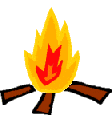 Quickly
he bent green willow sticks, planting both ends of each pole into the
earth. These he covered thick with reeds and grasses. Soon the straw
hut was ready. One by one the fat ducks waddled in through a small opening,
which was the only entranceway. Beside the door Iktomi stood smiling,
as the ducks, eying his bundle of songs, strutted into the hut.
Quickly
he bent green willow sticks, planting both ends of each pole into the
earth. These he covered thick with reeds and grasses. Soon the straw
hut was ready. One by one the fat ducks waddled in through a small opening,
which was the only entranceway. Beside the door Iktomi stood smiling,
as the ducks, eying his bundle of songs, strutted into the hut.
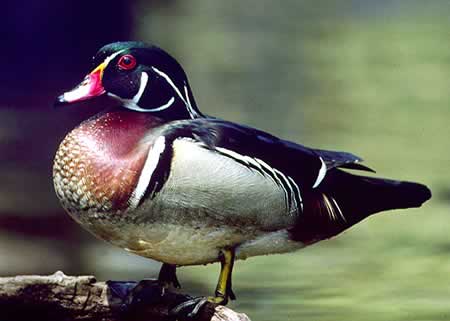 The
Wood Duck (Aix sponsa) is the only native species of perching duck in
North America. A member of the Anatidae family of ducks, geese, and
swans, the "woody" sports sharp claws for gripping snags and
clambering out of its tree-cavity nest.
The
Wood Duck (Aix sponsa) is the only native species of perching duck in
North America. A member of the Anatidae family of ducks, geese, and
swans, the "woody" sports sharp claws for gripping snags and
clambering out of its tree-cavity nest. 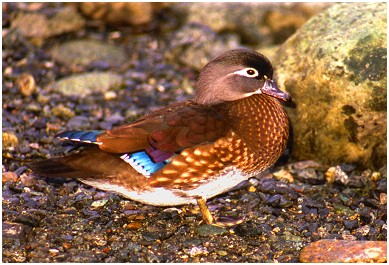 The
birds are intermediate in size between Mallards and teal: males weigh
about 680 g and females about 460 g.
The
birds are intermediate in size between Mallards and teal: males weigh
about 680 g and females about 460 g.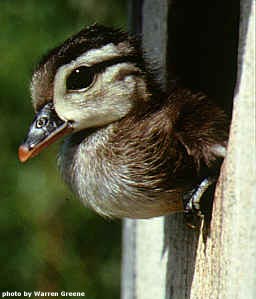 The
chicks hatch, downy and precocial, within hours of one another. (That
is, they are not the naked, helpless, altricial nestlings typical of
songbird species.) The next day, the female leaves the nest and gives
soft "kuk kuk kuk" calls. In response, the chicks, already
equipped with clawed feet, climb out of the cavity and drop to the ground
below. The hen and the young immediately set out for water, which provides
food and protection from land-based predators. Once on the water, ducklings
face natural enemies like large pickerel, pike, and snapping turtles.
The
chicks hatch, downy and precocial, within hours of one another. (That
is, they are not the naked, helpless, altricial nestlings typical of
songbird species.) The next day, the female leaves the nest and gives
soft "kuk kuk kuk" calls. In response, the chicks, already
equipped with clawed feet, climb out of the cavity and drop to the ground
below. The hen and the young immediately set out for water, which provides
food and protection from land-based predators. Once on the water, ducklings
face natural enemies like large pickerel, pike, and snapping turtles.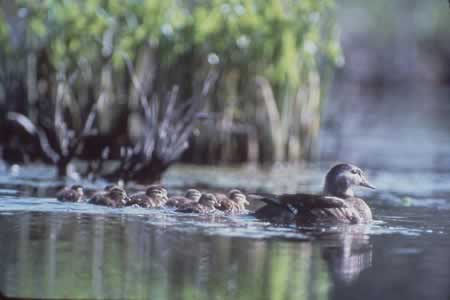 Like
many Anatidae species, the Wood Duck is a non-obligate intraspecific
brood parasite. That is, a female may lay some or all of her eggs in
the nest of another Wood Duck, to be incubated by the other duck. "Dump-nest"
clutches of up to 50 eggs can result. It may not be possible for the
hen whose nest has been so parasitized (the host) to successfully incubate
all the eggs, and thus some may not hatch. There is evidence that dumping
behavior increases as nests are more conspicuously placed and are spaced
more closely together.
Like
many Anatidae species, the Wood Duck is a non-obligate intraspecific
brood parasite. That is, a female may lay some or all of her eggs in
the nest of another Wood Duck, to be incubated by the other duck. "Dump-nest"
clutches of up to 50 eggs can result. It may not be possible for the
hen whose nest has been so parasitized (the host) to successfully incubate
all the eggs, and thus some may not hatch. There is evidence that dumping
behavior increases as nests are more conspicuously placed and are spaced
more closely together.